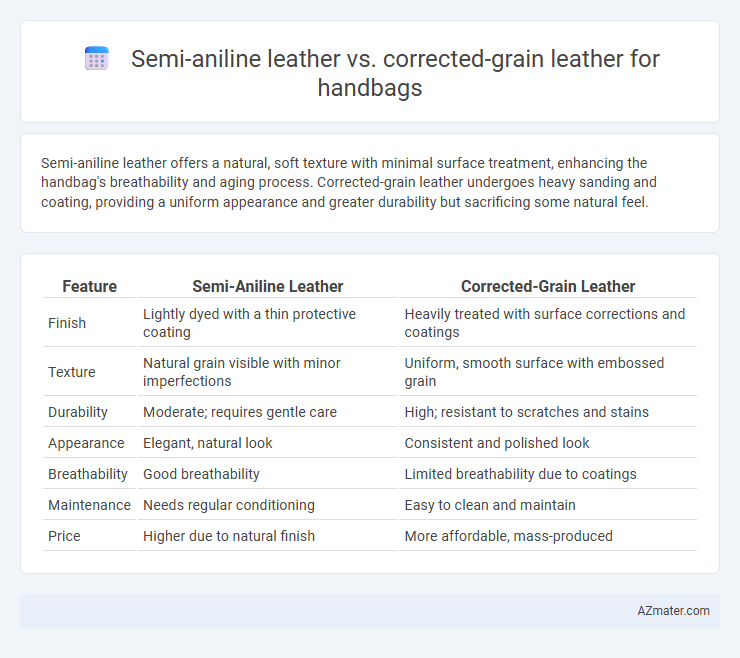Semi-aniline leather offers a natural, soft texture with minimal surface treatment, enhancing the handbag's breathability and aging process. Corrected-grain leather undergoes heavy sanding and coating, providing a uniform appearance and greater durability but sacrificing some natural feel.
Table of Comparison
| Feature | Semi-Aniline Leather | Corrected-Grain Leather |
|---|---|---|
| Finish | Lightly dyed with a thin protective coating | Heavily treated with surface corrections and coatings |
| Texture | Natural grain visible with minor imperfections | Uniform, smooth surface with embossed grain |
| Durability | Moderate; requires gentle care | High; resistant to scratches and stains |
| Appearance | Elegant, natural look | Consistent and polished look |
| Breathability | Good breathability | Limited breathability due to coatings |
| Maintenance | Needs regular conditioning | Easy to clean and maintain |
| Price | Higher due to natural finish | More affordable, mass-produced |
Understanding Semi-Aniline Leather: Key Features
Semi-aniline leather for handbags features a thin protective coating that maintains natural texture and pores while offering moderate stain resistance, making it softer and more breathable than corrected-grain leather. It displays unique aging characteristics and rich patina development due to minimal surface alteration, enhancing handbag aesthetics over time. Compared to corrected-grain leather, semi-aniline offers superior comfort and an authentic feel, though it requires careful maintenance to preserve its delicate finish.
What is Corrected-Grain Leather?
Corrected-grain leather is made by sanding the surface to remove imperfections, then applying a pigment coating to create a uniform appearance and enhanced durability. This treated leather resists stains and scratches better than semi-aniline leather, making it ideal for handbags that require both style and long-lasting wear. While semi-aniline leather retains more natural texture and breathability, corrected-grain leather offers a consistent finish and easier maintenance.
Manufacturing Process: Semi-Aniline vs Corrected-Grain
Semi-aniline leather undergoes a light dyeing process that preserves the natural surface and grain, resulting in a more authentic texture with minimal pigmentation and no surface coating. Corrected-grain leather is mechanically buffed or sanded to remove imperfections, then heavily pigmented and coated with a polymer finish to create a uniform appearance and enhanced durability. The semi-aniline process emphasizes natural beauty with slight protection, whereas corrected-grain manufacturing focuses on consistency and resistance to wear in handbag production.
Appearance and Texture Comparison
Semi-aniline leather offers a natural, soft texture with visible grain patterns and minimal surface coating, preserving the leather's original beauty and unique markings. Corrected-grain leather features a uniform, smooth surface achieved through sanding and heavy pigmentation, resulting in a more consistent appearance but less natural feel. For handbags, semi-aniline leather provides a softer, more luxurious touch with subtle imperfections, while corrected-grain leather ensures durability and resistance to stains with a polished look.
Durability and Wear Resistance
Semi-aniline leather offers moderate durability with its natural surface and minimal pigment coating, allowing some breathability while resisting light wear and scratches. Corrected-grain leather features a protective topcoat and embossed texture, significantly enhancing its wear resistance and ability to withstand daily abrasion and stains. For handbag use, corrected-grain leather provides superior durability and longevity in high-traffic conditions compared to the more delicate semi-aniline option.
Comfort and Softness: Which Feels Better?
Semi-aniline leather offers superior softness and natural breathability due to its minimal surface coating, allowing the material to adapt comfortably to the user's hand and body temperature. Corrected-grain leather features a thicker protective layer and embossed texture, making it more durable but less supple and less breathable compared to semi-aniline leather. For handbags prioritizing comfort and softness, semi-aniline leather generally feels more luxurious and pleasant to the touch, enhancing the carrying experience.
Maintenance and Care Requirements
Semi-aniline leather requires gentle maintenance with mild cleaners and regular conditioning to preserve its natural texture and color, avoiding exposure to direct sunlight or excessive moisture to prevent fading and stains. Corrected-grain leather offers enhanced durability and stain resistance due to its surface coating, allowing for easier cleaning with damp cloths and less frequent conditioning. Handbags made from semi-aniline leather demand more attentive care to maintain their luxurious appearance, while corrected-grain leather handbags provide a more practical, low-maintenance option ideal for everyday use.
Stain and Water Resistance
Semi-aniline leather features minimal pigment and is more porous, making it susceptible to stains and limited water resistance compared to corrected-grain leather. Corrected-grain leather undergoes surface treatment with pigments and sealants, providing enhanced protection against stains and water exposure, ideal for handbags used in varying conditions. For those prioritizing durability and ease of maintenance, corrected-grain leather offers superior stain and water resistance without compromising the handbag's appearance.
Cost Differences: Semi-Aniline vs Corrected-Grain
Semi-aniline leather typically costs more than corrected-grain leather due to its minimal surface treatment and higher quality dyeing process, which preserves the natural texture and softness of the hide. Corrected-grain leather undergoes extensive sanding and coating, making it more affordable but less breathable and supple. For handbags, the price difference reflects the balance between premium aesthetics and durability, with semi-aniline targeting luxury segments and corrected-grain appealing to budget-conscious buyers.
Which Leather is Best for Handbags?
Semi-aniline leather offers a natural, soft texture with minimal pigment coating, enhancing the durability and breathability for handbags, making it ideal for a luxurious yet practical choice. Corrected-grain leather undergoes heavy embossing and pigment application to mask imperfections, resulting in a more uniform, scratch-resistant surface that excels in longevity and easy maintenance. For handbags, semi-aniline leather is best for those valuing a premium, natural look, while corrected-grain leather suits users seeking enhanced durability and consistent appearance.

Infographic: Semi-aniline leather vs Corrected-grain leather for Handbag
 azmater.com
azmater.com